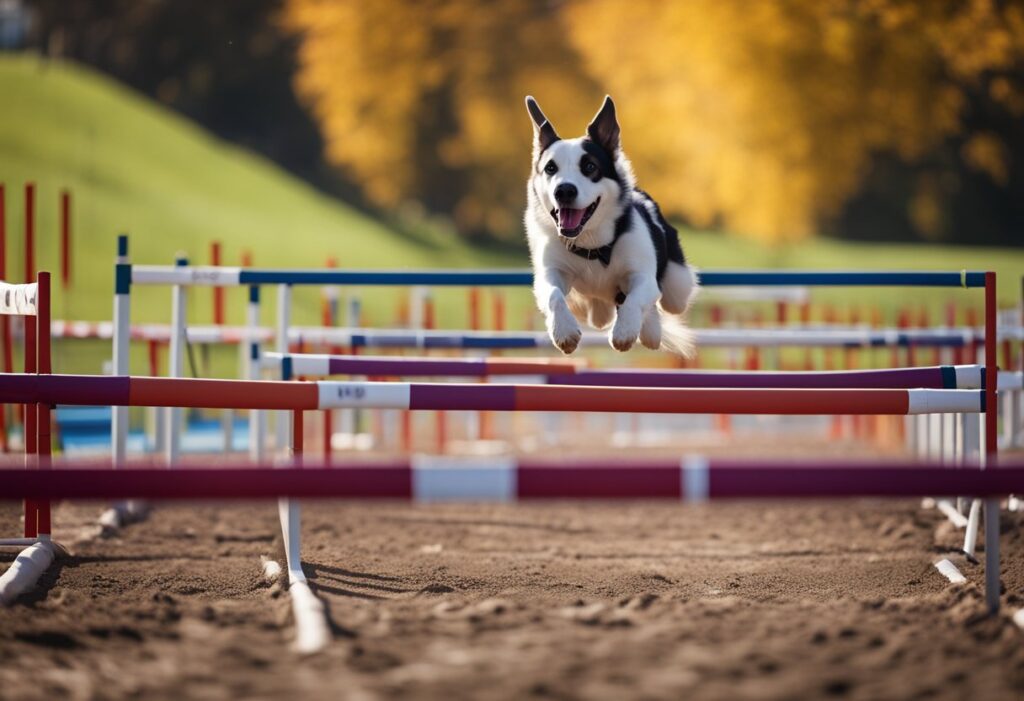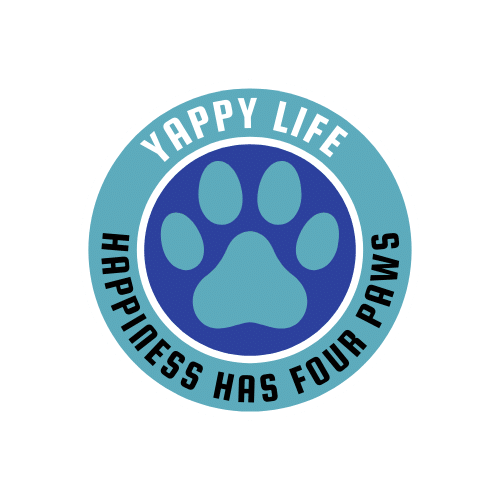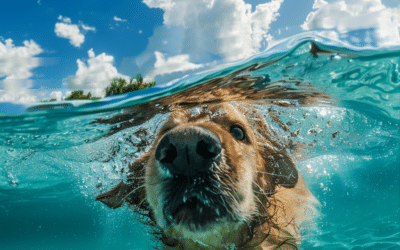What is Dog Agility: An Introduction to the Canine Sport
Dog agility is a dynamic sport where you and your dog navigate through a challenging obstacle course. This engaging activity not only stimulates your dog physically but also mentally, harnessing their natural instincts and energy in an exciting way. Agility courses include a variety of obstacles like jumps, tunnels, and weave poles, each designed to test your dog’s speed, dexterity, and cooperation between you and your dog.
In competitions, the goal is to complete the course accurately and as quickly as possible. Your role as a handler is pivotal; you lead your dog using only body signals and voice commands since physical contact with the dog or the equipment is not allowed during the run. The sport fosters an impressive level of training and communication, building a deep bond between you and your dog.
Whether you’re seeking a fun, recreational activity or you’re interested in pursuing agility at a competitive level, it offers numerous benefits. It can improve your dog’s fitness, provide mental stimulation, and enhance their obedience and trust. The sport is inclusive, allowing dogs of all breeds and sizes to participate and revel in the joy of running the course.
What is Dog Agility

Dog agility is a competitive sport designed to enhance the bond between you and your dog. It is an activity where you direct your dog through a timed obstacle course, testing both speed and precision.
The typical agility course includes a range of obstacles:
- Tunnels: Your dog must dash through these flexible tubes.
- Weave Poles: A straight line of poles your dog weaves in and out of at a brisk pace.
- Jumps: These can be hurdles or tire shapes that your dog leaps over.
- A-Frames: Large triangular structures your dog climbs up and down.
- See-saws (Teeters): Your dog must balance and tip the plank to walk across.
In agility, you may only use your voice, movement, and body signals to instruct your dog as they navigate off-leash. You are not allowed to touch the dog or the obstacles. This encourages a deep level of training and trust between you and your dog.
The American Kennel Club outlines that courses typically have between 14-20 obstacles. The nature of the sport also promotes physical fitness and mental sharpness for both you and your dog. It is highly engaging and fosters a unique sense of teamwork and accomplishment as you both work through the course challenges.
While competition can be a goal, many participants enjoy agility training for fun, its ability to build confidence in dogs, and the joy of shared activity with their four-legged companions.
Getting Started with Dog Agility
Embarking on dog agility training enriches the bond between you and your dog, enhances their fitness, and hones their obedience. This section will guide you through the essential steps: grasping the agility basics, initial training tips, and selecting an appropriate agility class.
Understanding Agility
Dog agility is a competitive sport designed to showcase a dog’s speed, agility, and the relationship with their handler. As a beginner, you will guide your dog through a series of obstacles such as jumps, tunnels, and weave poles. It is crucial to approach agility training with a clear understanding of the standard equipment and competition rules. Begin by familiarizing yourself with the different breeds that excel in agility and recognize that, while some are natural fits, most breeds or mixed breeds can participate and enjoy agility with the right training.
Beginner Training Tips
When starting out, focus on foundational skills. Establish clear communication through consistent commands and body language. This will ensure your dog can navigate through obstacles effectively. It’s recommended to start simple:
- Jumps: Set up low hurdles and encourage your dog to leap calmly over them.
- Tunnels: Use a collapsed tunnel at first, gradually increasing to a full tunnel as your dog gains confidence.
- Contact obstacles: Introduce your dog to contact obstacles, like the A-frame, ensuring they learn to touch the contact zones.
Safety is paramount; always ensure the equipment you use is secure and suited to your dog’s size and ability.
Choosing the Right Dog Agility Class
Selecting the proper class is pivotal for a successful agility journey. Look for classes that cater to beginners and match your schedule. Research potential classes’ reputations and teaching methodologies, and consider these factors:
- Instructor experience: Knowledgeable instructors are crucial for effective training.
- Class size: A smaller class size ensures more individual attention.
- Location and schedule: Choose a convenient location with a schedule that fits yours.
Classes can vary widely in terms of philosophy and methods, so don’t hesitate to observe a class in action or ask for recommendations from experienced agility participants.
Dog Agility Equipment and Setup
In dog agility, your quick and nimble canine navigates through a series of challenges, testing speed and dexterity. The right equipment and setup are vital for success in this dynamic sport.
Essential Obstacles
Weave Poles: Weave poles are a must-have in any agility obstacle course. Usually a set of 5 to 12 upright poles, your dog must weave through them without skipping any poles or circling back.
Jumps: Including bar jumps, tire jumps, and broad jumps, these obstacles require your dog to leap cleanly over horizontal bars or through a suspended tire. The height of the bars can typically be adjusted to your dog’s size and skill level.
Tunnels: Agility tunnels come in both standard and collapsible forms. Your dog must dash through the tunnel without hesitation, which is an excellent test of their willingness to tackle enclosed spaces.
Contact Obstacles: These include the A-frame, seesaws, and dog walks. Your dog must climb up and down these pieces without jumping off prematurely, making contact with the safety zones painted on either side.
Hurdles: Hurdles or jump sets challenge your dog’s jumping abilities and are perfect for practicing clearance and landing techniques.
Home Practice Essentials
To set up a home agility course, you’ll need a selection of the following:
- Weave poles: a starter set of 6 poles for weaving practice.
- Adjustable hurdle: with options to raise or lower the height for jump training.
- Tunnel: a collapsible option for easy storage.
- Tire jump: a stand-alone tire jump that can be adjusted for different sizes.
Amazon has several agility kits that contain everything you’ll need or you can build it yourself. Take a look at blog post on agility course ideas for your backyard.
Always remember to include a leash when not competing to guide your dog safely through new equipment. Contact obstacle trainers are also available, which are smaller and safer for home use, such as mini A-frames or seesaw platforms. Your dog’s agility practice at home reinforces commands and boosts confidence for official competitions. Affordable, simple options are available that can mimic competition-style equipment, aiding with consistent training.
Dog Agility Competitions
In dog agility competitions, your goal is to guide your dog through an obstacle course with precision and speed. Success requires training, skill, and knowledge of the competition’s rules and scoring methods.
Preparing for Competition
To compete effectively in an agility competition, start with sound preparation. Your dog should have high levels of energy and focus, as agility trials test both mental and physical abilities. Training often involves working on specific obstacles like jumps, tunnels, and weave poles, developing your dog’s speed and your handling skills. Organizations such as the American Kennel Club (AKC) and the United States Dog Agility Association (USDAA) offer resources and guidelines for getting started in all-breed agility trials, specialty trials, and group trials. For optimal preparation, familiarize yourself with the AKC Agility Course Test (ACT), which is a good starting point for beginners.
- Training Focus:
- Obstacle navigation: Practice on jumps, tunnels, weave poles.
- Speed and endurance: Incorporate regular exercise.
- Handler-dog communication: Improve with consistent cues and body language.
Understanding Rules and Scoring
When involved in agility competitions, it’s crucial to understand the regulations and how scoring works. Faults can occur when you or your dog make a mistake, like knocking down a bar or missing an obstacle. Each fault leads to point deductions which affect your total score. The AKC offers competition formats like Standard and Jumpers with Weaves, each with its own set of rules.
Scoring Factors:
- Timeliness: Completion of the course within the standard course time (SCT).
- Accuracy: Avoiding faults such as missed contacts, knocked bars, or refusal of obstacles.
- Handling: The effectiveness of your communication and control during the run.
By understanding these aspects, you can fine-tune your strategy and performance in agility competitions, aiming for both speed and accuracy on the course.
Advanced Agility Training and Health

When advancing to higher levels of agility training with your dog, it becomes paramount to focus on building a robust partnership and prioritizing health and safety to prevent injuries.
Building a Stronger Bond
Advanced agility training takes the partnership between you and your dog to new heights. As you progress, your communication must be flawless, fostering an unparalleled bond. Your confidence in each other grows with every session, forming an intuitive team dynamic. Through complex courses and intricate exercises, the trust and patience you develop with your dog are crucial for a successful and fun agility journey.
Injury Prevention and Health
Safety always comes first in agility training to keep the activity fun and beneficial for both of you. Your dog needs to be fit to handle advanced courses, which means a solid regimen of conditioning and warm-up exercises is essential to prevent injuries. Always ensure your dog has gone through a thorough veterinary check-up before increasing the intensity of training. Developing skills like balance, flexibility, and strength in your canine companion is vital for a healthy progression in agility. Remember, patience is key, as rushing into complex routines can lead to unnecessary strain or injuries.
In conclusion, dog agility is a fun and exciting sport that involves a dog navigating an obstacle course with speed and precision. It’s a great way to bond with your furry friend while keeping them mentally and physically active. Remember, dog agility isn’t just for professional trainers or purebred dogs – any dog can participate and enjoy the benefits of this activity. It’s a fantastic way to build trust and communication with your pet.





Recent Comments